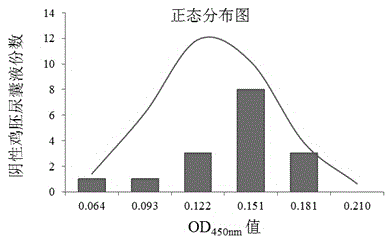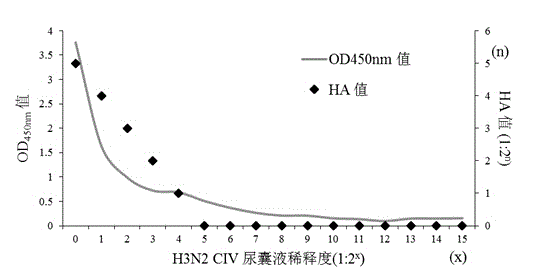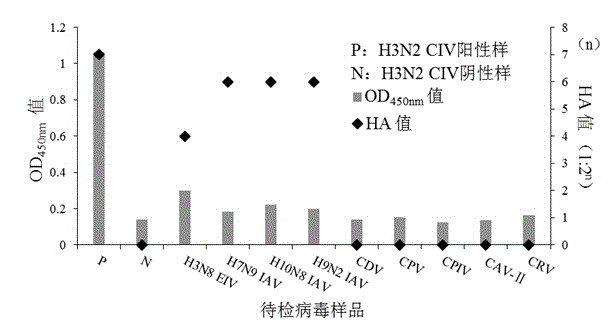Kit for detecting H3N2 subtype canine influenza virus
A technology of canine influenza virus and H3N2, which is applied in the field of immunology, can solve the problems of unfavorable clinical research and development, the lack of H3N2 canine influenza virus, etc., and achieve the effect of high sensitivity, good repeatability and stability, and strong specificity
- Summary
- Abstract
- Description
- Claims
- Application Information
AI Technical Summary
Problems solved by technology
Method used
Image
Examples
Embodiment 1
[0032] The preparation of embodiment 1 hybridoma cell line
[0033] 1. Antigen preparation of H3N2 subtype canine influenza virus
[0034] The strain A / canine / Guangdong / 1 / 2006 (H3N2) (abbreviated as CGD1) used in the present invention has the Genbank accession numbers GU433345.1, GU433346.1, GU433347.1, GU433348.1, GU433349.1, GU433350 .1, GU433351.1, GU433352.1, strains and their sequence reference website: http: / / www.ncbi.nlm.nih.gov / nuccore / ? term=A%2Fcanine%2FGuangdong%2F1%2F2006%28H3N2%29.
[0035] 1. Virus expansion culture: Inoculate the allantoic cavity of 10-day-old SPF chicken embryos with the diluted chicken embryo allantoic fluid of CGD1 strain, the inoculation volume is 0.15mL / embryo, and incubate at 37°C. Observe once every 12 hours, discard the dead chicken embryos within 24 hours, and store the dead embryos after 24 hours in a refrigerator at 4°C. After 96 hours, all the chicken embryos were cooled overnight at 4°C, the allantoic fluid of the chicken embryos...
Embodiment 2
[0091] The preparation of embodiment 2 monoclonal antibody
[0092] Female BALB / c mice were intraperitoneally injected with FICA, 0.5 mL / mouse. After 7 days, the hybridoma cells 2C5 in the logarithmic growth phase were suspended and washed with sterilized physiological saline (take the supernatant of the cell culture fluid in the logarithmic growth phase to measure the McAb titer), and the cell density was adjusted to 2×10 6 individual / mL. Each mouse was intraperitoneally injected with 0.5mL cell suspension, and observed whether the abdomen of the mouse was swollen day by day. When the ascites was obviously swollen, the ascites was taken out, placed in an EDTA-treated anticoagulant tube, and centrifuged at 5,000r / min for 10min to remove the cells. precipitation. The collected supernatant was inactivated at 56° C. for 30 minutes, centrifuged at 10,000 r / min for 15 minutes, and then purified. Do a good job of disinfection before and after the extraction of mouse ascites, and ...
Embodiment 3
[0126] Example 3 Establishment of Double Antibody Sandwich ELISA Detection Method
[0127] Preparation of rabbit-derived polyclonal antibody: Take two 3kg New Zealand white rabbits, phacoemulsify with purified H3N2 CIV and the same amount of FCA, and inject subcutaneously in multiple points on the back, 1.5mg / rat. The second immunization and the third immunization were emulsified with FICA and H3N2 CIV on the 14th day and 28th day after the first immunization, respectively, and then injected subcutaneously as the antigen, 2 mg per mouse. After the third immunization, blood was collected from the heart, the serum was separated, and stored at -20°C for future use. The titer of the antiserum was determined by indirect ELISA, and the polyclonal antibody concentration after purification (purification steps were the same as in Example 2) was measured using a micro-spectrophotometer, and the purified samples were stained with Coomassie brilliant blue to detect the purification effect...
PUM
| Property | Measurement | Unit |
|---|---|---|
| concentration | aaaaa | aaaaa |
Abstract
Description
Claims
Application Information
 Login to View More
Login to View More - R&D
- Intellectual Property
- Life Sciences
- Materials
- Tech Scout
- Unparalleled Data Quality
- Higher Quality Content
- 60% Fewer Hallucinations
Browse by: Latest US Patents, China's latest patents, Technical Efficacy Thesaurus, Application Domain, Technology Topic, Popular Technical Reports.
© 2025 PatSnap. All rights reserved.Legal|Privacy policy|Modern Slavery Act Transparency Statement|Sitemap|About US| Contact US: help@patsnap.com



